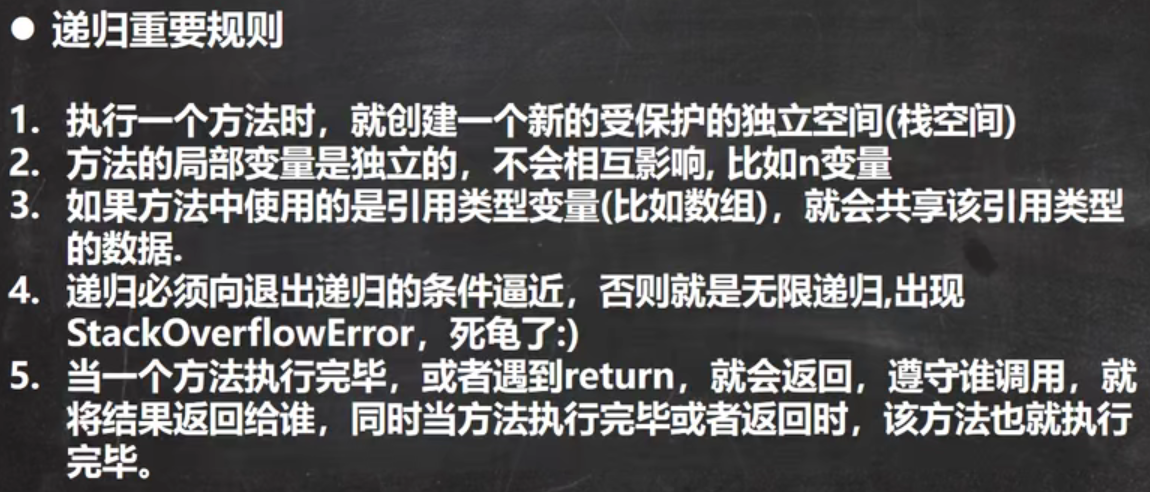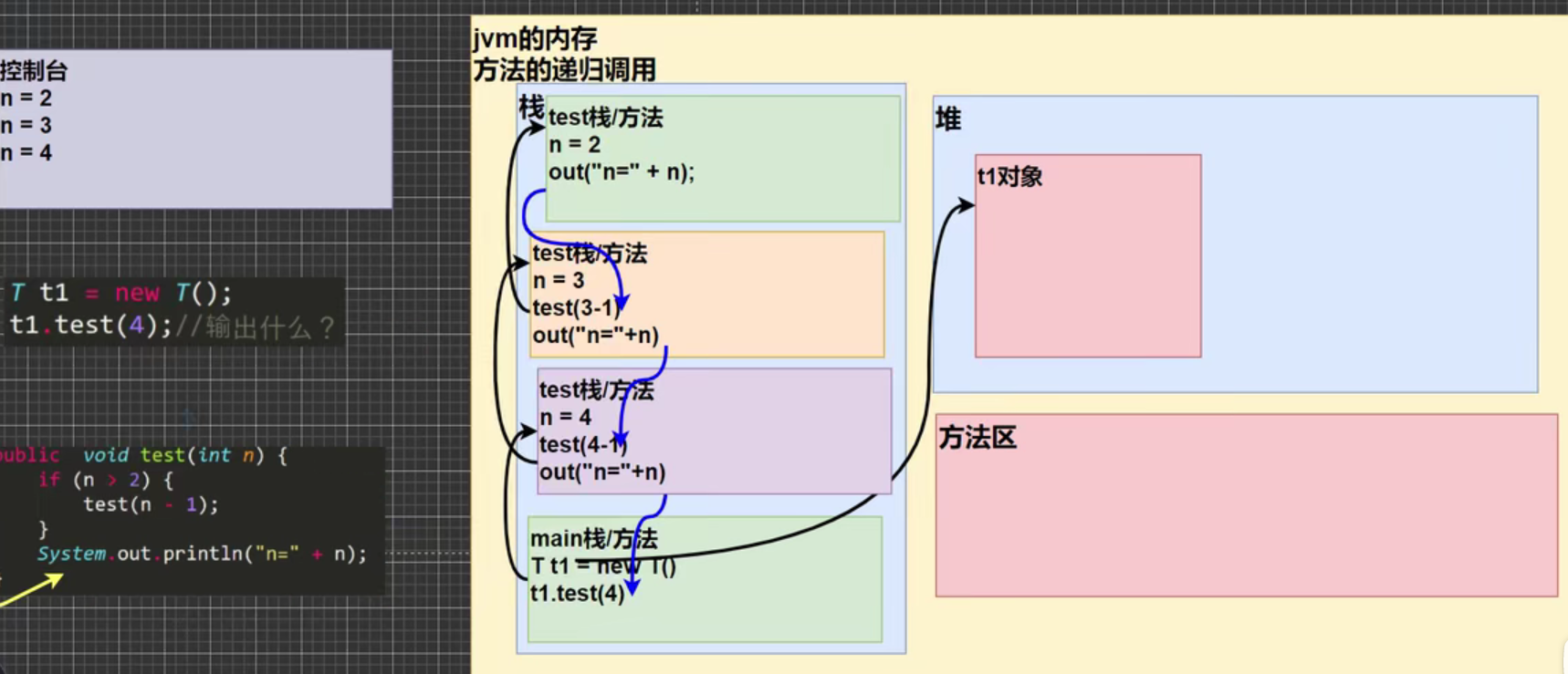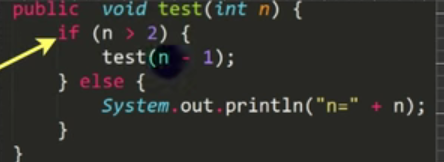韩顺平java07(递归)
递归(recursion)

- 首先明确一个知识点——方法执行完后会返回到调用它的地方。
小例子:

每个栈都会走玩自己的流程在释放,n=2的时候开始释放,然后逐级返回到上一个栈空间——即调用自己的地方,然后开始打印。
如果改成:

则只输出一个n=2,以为在开始返回的时候之前栈的n都>2所以就不走else语句了,只输出一次栈顶的n=2。
- 阶乘(Factorial)
public static void main(String[] args) { System.out.println(factorial(5)); } public static int factorial(int i){ if (i==1){ return 1; }else{ return factorial(i-1)*i; } }
- 斐波那契数列(Fibonacci)
public static void main(String[] args) { for (int i = 1; i < 10; i++) { System.out.println("第"+i+"个斐波那契数为:" + fibonacci(i) + "\t"); } } public static int fibonacci(int i){ if (i==1||i==2){ return 1; }else{ return fibonacci(i-2)+fibonacci(i-1); } }
- 猴子吃桃
//猴子吃桃问题----猴子每天吃总数一般的桃子再多吃一个, // 第十天想吃的时候发现只剩一个,问一开始有多少桃子 // 第n天=(第n+1天+1)*2 第十天=1 递归九次 public static void main(String[] args) { System.out.println(peach(11)); } public static int peach(int day){ if (day == 10){ return 1; }else if (day >= 1 && day <= 9){ return (peach(day +1 )+1)*2; }else{ System.out.println("没桃子了!"); return -1; }
- 迷宫问题
package oop; public class MiGong { public static void main(String[] args) { Tool t = new Tool(); int[][] map = new int[8][7]; System.out.println("打印地图:"); for (int i = 0; i < map.length; i++) {//外循环次数为二维数组的行数 即array.length-1次 for (int j = 0; j < map[i].length; j++) {//内循环次数为一维数组的长度 即array[i].length-1次 map[i][0] = 1; map[i][6] = 1; map[0][j] = 1; map[7][j] = 1; } } map[3][1] = 1; map[4][5] = 1; map[5][4] = 1; t.sort(map); t.findWay(map,1,1); System.out.println("路径:"); t.sort(map); } } class Tool { public boolean findWay(int[][] map, int i, int j) { //0表示路,1表示墙,2表示走过的路,3表示走过但走不通的死路 //起始位置为(1,1),终点为(6,5) //策略为下->右->上->左 if (map[6][5] == 2) {//表示已经到终点了 return true; }else if(map[i][j] == 0){//表示可以走 //先假定当前位置可以走通 map[i][j]=2; //开始使用策略 if (findWay(map,i+1,j)){//如果将地图传入,并且先向下走 return true; }else if (findWay(map,i,j+1)){//向右走 return true; }else if (findWay(map,i-1,j)){//向上走 return true; }else if (findWay(map,i,j-1)){//向左走 return true; }else{ map[i][j]=3; //四个方向都走不通判定为死路 return false; } }else{//可能的情况---1(是墙),2(来路先不回去),3(死路) return false; } } public void sort(int[][] array) {//遍历方法 for (int i = 0; i < array.length; i++) {//外循环次数为二维数组的行数 即array.length-1次 for (int j = 0; j < array[i].length; j++) {//内循环次数为一维数组的长度 即array[i].length-1次 System.out.print(array[i][j] + "\t"); } System.out.println(); } } }
- 汉诺塔问题
public class HanoiTower { //汉诺塔问题 public static void main(String[] args) { Tower tower = new Tower(); tower.move(5,'A','B','C'); System.out.println("需要"+tower.count+"次"); } } class Tower { int count = 0; public void move(int num,char a,char b, char c){ if (num == 1){ count ++; System.out.println(a+" - >" + c);//递归最内层 }else{ move(num - 1,a,c,b);//先将a上面的num-1个移动到b上面 System.out.println(a+" - >" + c); //将a上面的一个移动到c count ++; move(num-1 ,b,a,c);//先将b上面的num-1个移动到c上面 } } }
本文来自博客园,作者:紫英626,转载请注明原文链接:https://www.cnblogs.com/recorderM/p/15664542.html


